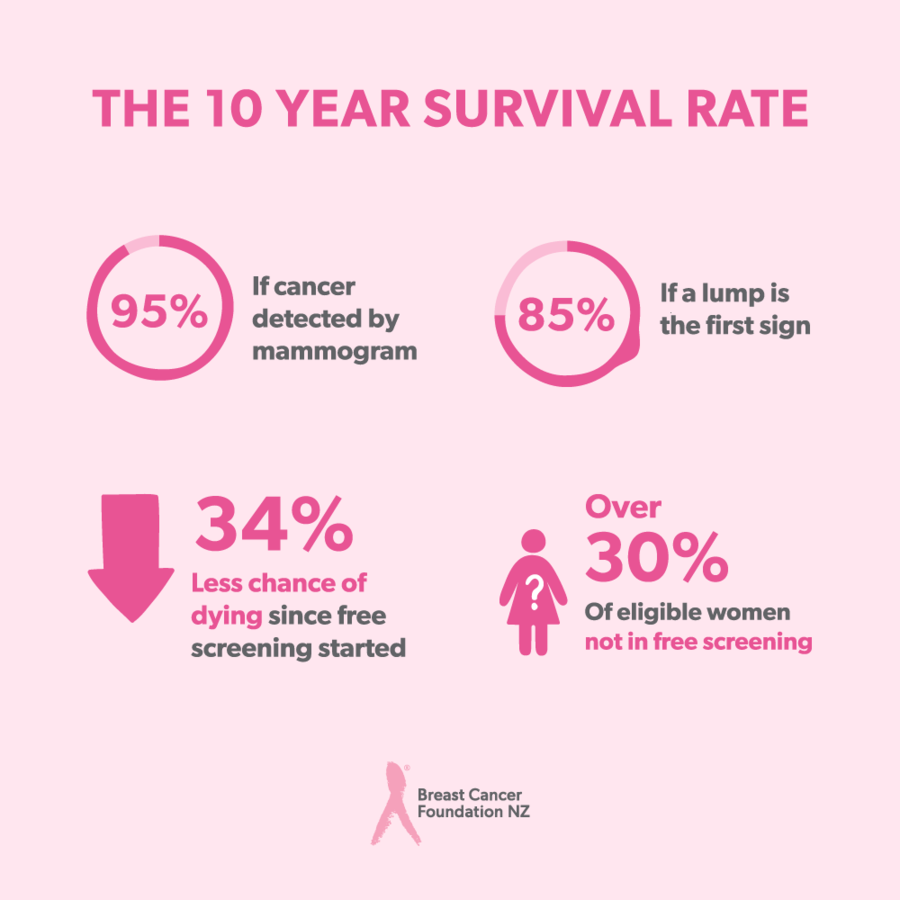Breast cancer is the most common cancer for Kiwi women and the third most common cancer overall
It affects one in nine New Zealand women over their lifetime.
About 70% - 75% of women who are diagnosed with breast cancer and about 80% of women who die from it are aged 50 years or older. Some women are at greater risk of breast cancer because there is a history of close family members having the disease. However, most women who develop breast cancer have no relatives with the disease. Even among women who do have relatives with breast cancer, most will never develop it. (Ministry of Health 2015)
While it is less common, young women can get breast cancer too. 6% of breast cancer in New Zealand occurs under the age of 40 years. Although it is uncommon, men also get breast cancer. About 25 men are diagnosed in New Zealand each year.
Nine New Zealand women, on average, will hear the news today that they have breast cancer.
Overall, 85% of people with breast cancer survive 10 years or more (95% if detected on a screening mammogram) but tragically, more than 650 women die of the disease every year.

How well is NZ doing in tackling breast cancer?
In the first and biggest study of its kind, we’ve analysed data in Te Rēhita Mate Ūtaetae - Breast Cancer Foundation National Register.
Our report, 30,000 voices: Informing a better future for breast cancer in Aotearoa New Zealand, looks at how New Zealand is doing when it comes to breast cancer diagnoses and treatment.
Age risk
As indicated in the following table, a woman’s chance of developing breast cancer increases with age. Approximately 70% - 75% of breast cancers are diagnosed in women 50 years and older. While breast cancer is less common in women under the age of 40, women in their 20s and 30s can get it too (approximately 6% of cases are in this age group).
| If a women is now in her: | Risk of breast cancer in the next ten years: |
| 20s | 1 in 1,314 |
| 30s | 1 in 204 |
| 40s | 1 in 50 |
| 50s | 1 in 37 |
| 60s | 1 in 29 |
| 70s | 1 in 36 |
Recent research from Australia and the United Kingdom shows a one in nine lifetime risk of a woman being diagnosed with breast cancer; however, the USA has a higher incidence with a one in eight to one in seven lifetime risk.
Diagnosis rates
The following table shows that while the number of people (female and male) diagnosed with breast cancer in NZ is increasing (18% over the last decade), the mortality rate from breast cancer has fallen more than 30% over the last 30 years.
| Year | Diagnosed | Deaths |
|---|---|---|
| 2005 | 2458 | 648 |
| 2006 | 2556 | 614 |
| 2007 | 2565 | 643 |
| 2008 | 2713 | 618 |
| 2009 | 2759 | 658 |
| 2010 | 2791 | 641 |
| 2011 | 2867 | 636 |
| 2012 | 3019 | 617 |
| 2013 | 3020 | 633 |
| 2014 | 3266 | 607 |
| 2015 | 3322 | 669 |
| 2016 | 3334 | 668 |
| 2017 | 3320 | 672 |
| 2018 | 3572 | 685 |
| 2019 | 3435 | n/a |
| 2020 | 3475 | 642 |
| 2021 | 3600 | 662 |
Some possible explanations for the increasing incidence are:
- An increase in the number of women attending breast screening
- An ageing population – simply getting older increases the risk for most cancers
- Lifestyle factors, such as increased alcohol consumption and the rise of obesity rates
- Having children at an older age, and having fewer children, along with a reduction in breastfeeding rate.
Source: International Agency for Research on Cancer (IARC) and World Health Organization (WHO)
